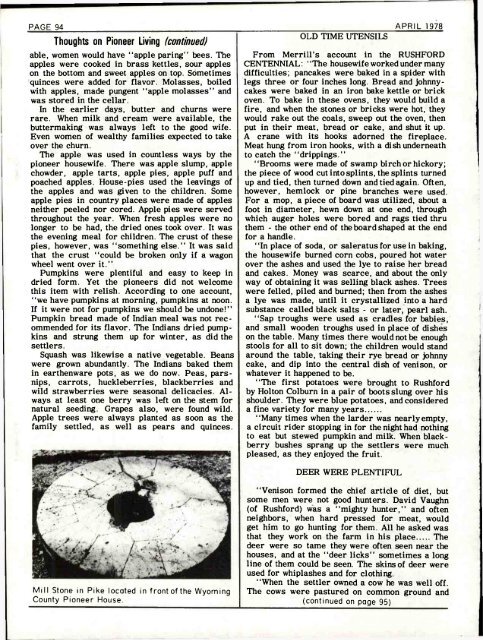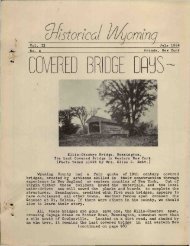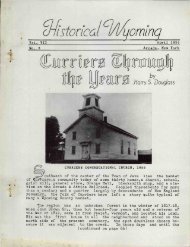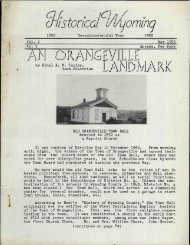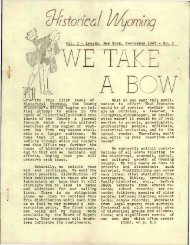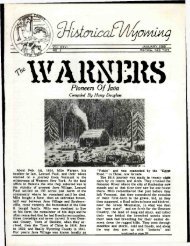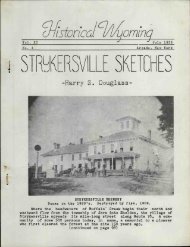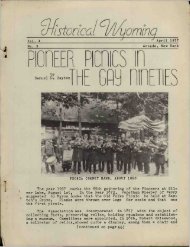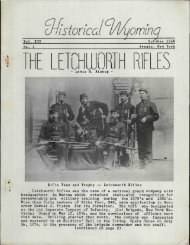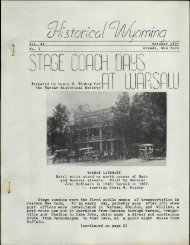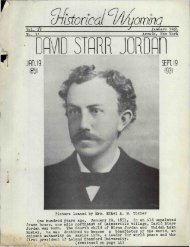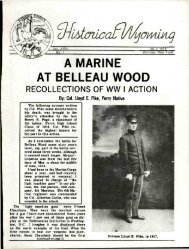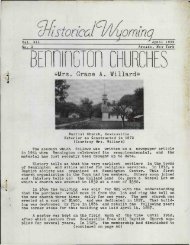By C. Kihm Richardson Walking from Strykersville ... - Fulton History
By C. Kihm Richardson Walking from Strykersville ... - Fulton History
By C. Kihm Richardson Walking from Strykersville ... - Fulton History
You also want an ePaper? Increase the reach of your titles
YUMPU automatically turns print PDFs into web optimized ePapers that Google loves.
PAGE 94<br />
Thoughts on Pioneer Living (continued)<br />
able, women would have "apple paring" bees. The<br />
apples were cooked in brass kettles, sour apples<br />
on the bottom and sweet apples on top. Sometimes<br />
quinces were added for flavor. Molasses, boiled<br />
with apples, made pungent "apple molasses" and<br />
was stored in the cellar.<br />
In the earlier days, butter and churns were<br />
rare. When milk and cream were available, the<br />
buttermaking was always left to the good wife.<br />
Even women of wealthy families expected to take<br />
over the churn.<br />
The apple was used in countless ways by the<br />
pioneer housewife. There was apple slump, apple<br />
chowder, apple tarts, apple pies, apple puff and<br />
poached apples. House-pies used the leavings of<br />
the apples and was given to the children. Some<br />
apple pies in country places were made of apples<br />
neither peeled nor cored. Apple pies were served<br />
throughout the year. When fresh apples were no<br />
longer to be had, the dried ones took over. It was<br />
the evening meal for children. The crust of these<br />
pies, however, was "something else." It was said<br />
that the crust "could be broken only if a wagon<br />
wheel went over it."<br />
Pumpkins were plentiful and easy to keep in<br />
dried form. Yet the pioneers did not welcome<br />
this item with relish. According to one account,<br />
"we have pumpkins at morning, pumpkins at noon.<br />
If it were not for pumpkins we should be undone!"<br />
Pumpkin bread made of Indian meal was not recommended<br />
for its flavor. The Indians dried pumpkins<br />
and strung them up for winter, as did the<br />
settlers.<br />
Squash was likewise a native vegetable. Beans<br />
were grown abundantly. The Indians baked them<br />
in earthenware pots, as we do now. Peas, parsnips,<br />
carrots, huckleberries, blackberries and<br />
wild strawberries were seasonal delicacies. Always<br />
at least one berry was left on the stem for<br />
natural seeding. Grapes also, were found wild.<br />
Apple trees were always planted as soon as the<br />
family settled, as well as pears and quinces.<br />
Mill Stone in Pike located in front of the Wyoming<br />
County Pioneer House.<br />
OLD TIME UTENSILS<br />
APRIL 1978<br />
From Merrill's account in the RUSHFORD<br />
CENTENNIAL: "The housewife worked under many<br />
difficulties; pancakes were baked in a spider with<br />
legs three or four inches long. Bread and johnnycakes<br />
were baked in an iron bake kettle or brick<br />
oven. To bake in these ovens, they would build a<br />
fire, and when the stones or bricks were hot, they<br />
would rake out the coals, sweep out the oven, then<br />
put in their meat, bread or cake, and shut it up.<br />
A crane with its hooks adorned the fireplace.<br />
Meat hung <strong>from</strong> iron hooks, with a dish underneath<br />
to catch the "drippings."<br />
"Brooms were made of swamp birch or hickory;<br />
the piece of wood cut into splints, the splints turned<br />
up and tied, then turned down and tied again. Often,<br />
however, hemlock or pine branches were used.<br />
For a mop, a piece of board was utilized, about a<br />
foot in diameter, hewn down at one end, through<br />
which auger holes were bored and rags tied thru<br />
them - the other end of the board shaped at the end<br />
for a handle.<br />
"In place of soda, or saleratus for use in baking,<br />
the housewife burned corn cobs, poured hot water<br />
over the ashes and used the lye to raise her bread<br />
and cakes. Money was scarce, and about the only<br />
way of obtaining it was selling black ashes. Trees<br />
were felled, piled and burned; then <strong>from</strong> the ashes<br />
a lye was made, until it crystallized into a hard<br />
substance called black salts - or later, pearl ash.<br />
"Sap troughs were used as cradles for babies,<br />
and small wooden troughs used in place of dishes<br />
on the table. Many times there would not be enough<br />
stools for all to sit down; the children would stand<br />
around the table, taking their rye bread or johnny<br />
cake, and dip into the central dish of venison, or<br />
whatever it happened to be.<br />
"The first potatoes were brought to Rushford<br />
by Holton Colburn in a pair of boots slung over his<br />
shoulder. They were blue potatoes, and considered<br />
a fine variety for many years<br />
"Many times when the larder was nearly empty,<br />
a circuit rider stopping in for the night had nothing<br />
to eat but stewed pumpkin and milk. When blackberry<br />
bushes sprang up the settlers were much<br />
pleased, as they enjoyed the fruit.<br />
DEER WERE PLENTIFUL<br />
"Venison formed the chief article of diet, but<br />
some men were not good hunters. David Vaughn<br />
(of Rushford) was a "mighty hunter," and often<br />
neighbors, when hard pressed for meat, would<br />
get him to go hunting for them. All he asked was<br />
that they work on the farm in his place The<br />
deer were so tame they were often seen near the<br />
houses, and at the "deer licks" sometimes a long<br />
line of them could be seen. The skins of deer were<br />
used for whiplashes and for clothing.<br />
"When the settler owned a cow he was well off.<br />
The cows were pastured on common ground and<br />
(continued on page 95)


